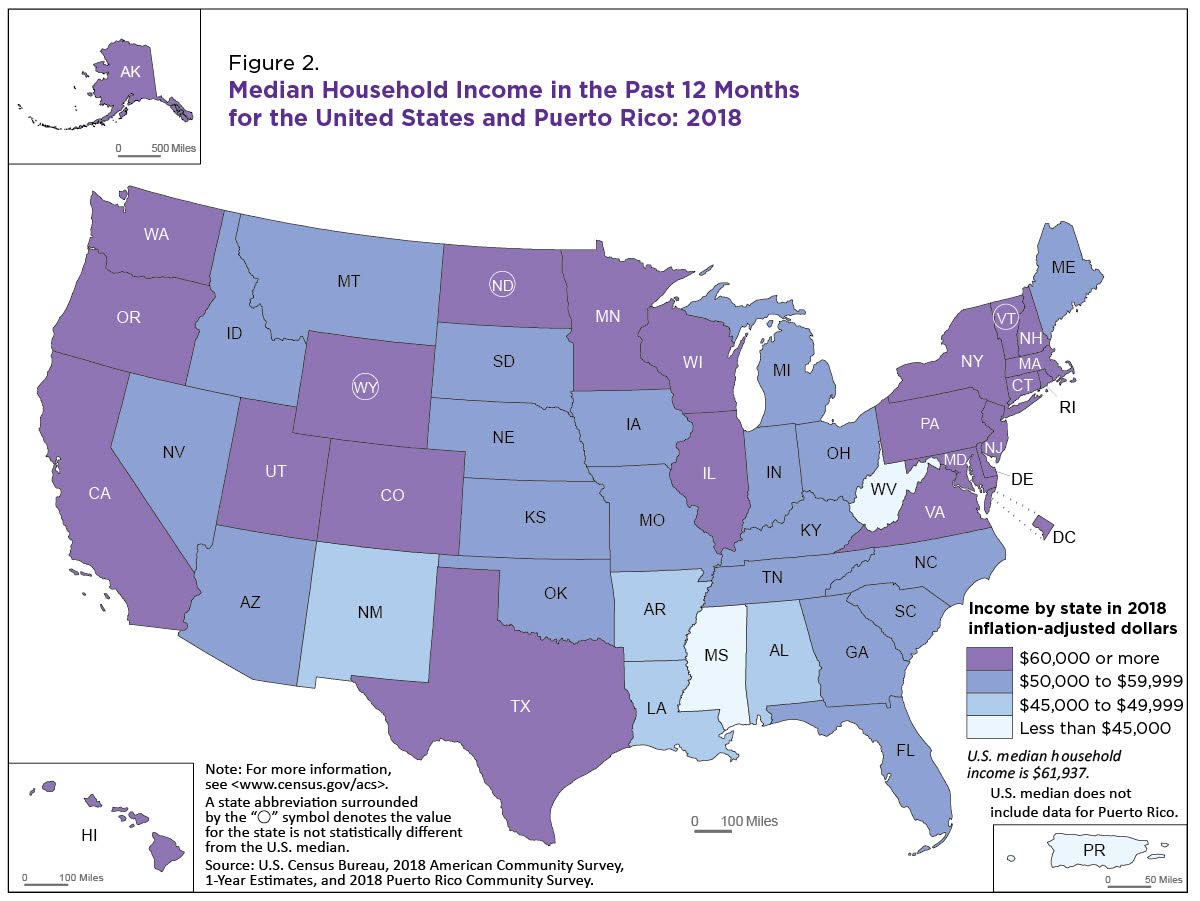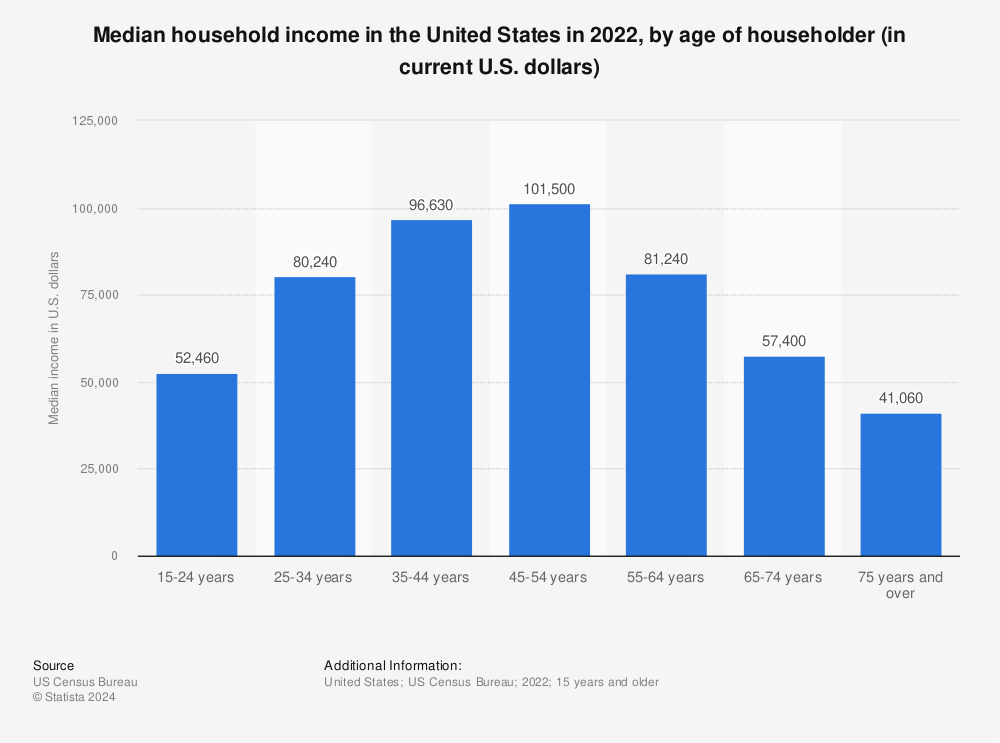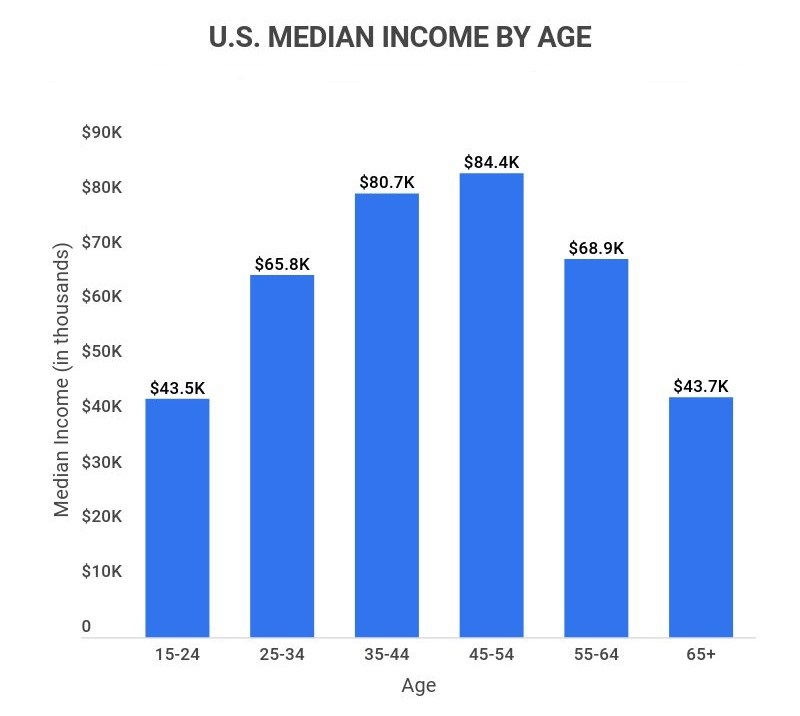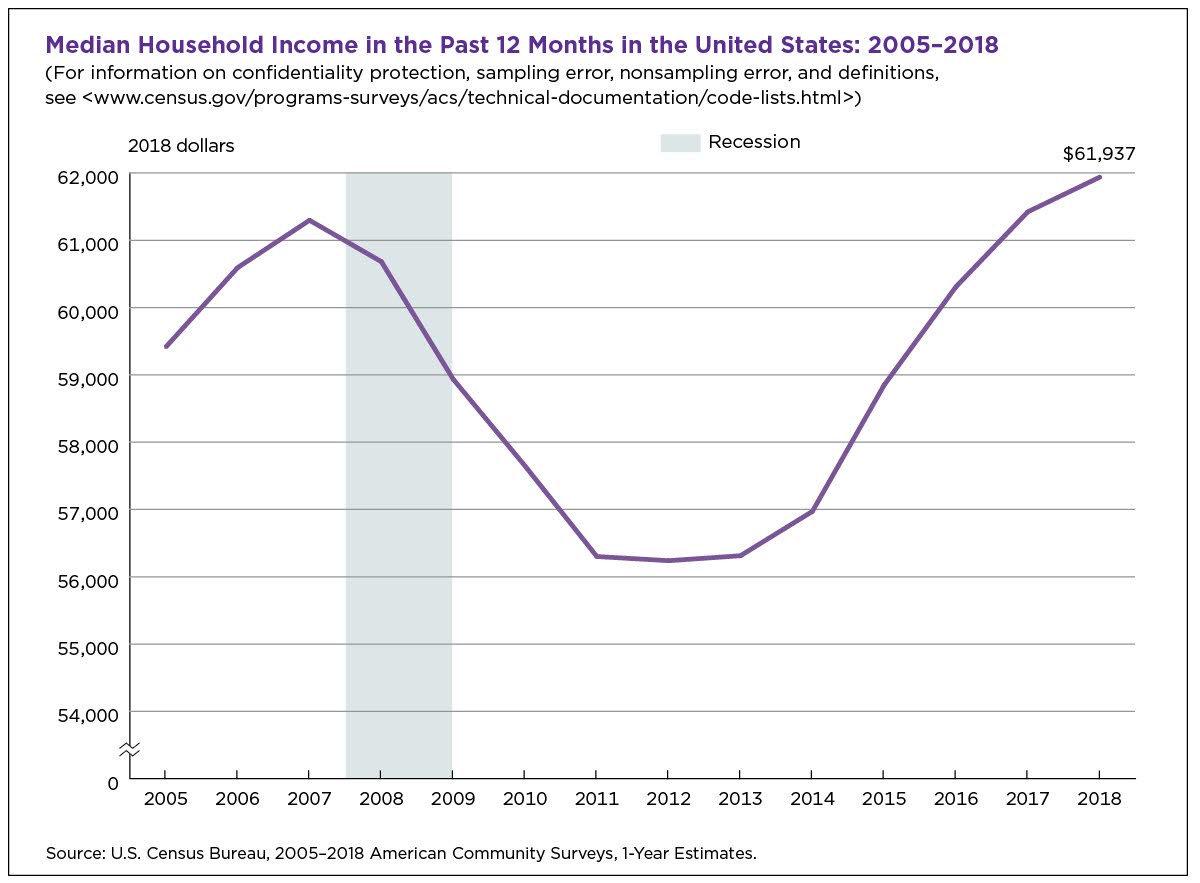What is the Median Salary in the United States?
The median salary in the United States is a statistical measure that represents the middle value of all salaries earned by Americans. It is a crucial indicator of the average income of the population, providing insights into the overall economic well-being of the country. The median salary is calculated by arranging all salaries in ascending order and selecting the middle value, which is the salary that separates the lower half from the upper half of the population.
As of 2022, the median salary in the United States is approximately $47,928 per year, according to data from the U.S. Bureau of Labor Statistics (BLS). This figure has been steadily increasing over the years, with a growth rate of about 3% per annum. However, it is essential to note that median salaries can vary significantly depending on factors such as industry, location, occupation, and level of experience.
Understanding the median salary in the United States is vital for individuals, businesses, and policymakers. It helps individuals gauge their earning potential and make informed decisions about their careers and financial planning. For businesses, median salary data can inform hiring decisions, compensation packages, and talent acquisition strategies. Policymakers can use median salary data to evaluate the effectiveness of economic policies and make data-driven decisions to promote economic growth and development.
The median salary in the United States is also influenced by demographic factors, such as age, education level, and geographic location. For instance, workers with higher levels of education tend to earn higher median salaries, while those living in areas with a high cost of living may require higher salaries to maintain a similar standard of living.
In conclusion, the median salary in the United States is a critical metric that provides insights into the economic well-being of the population. By understanding the median salary and its underlying factors, individuals and organizations can make informed decisions to promote economic growth, development, and prosperity.
Factors Affecting Median Salary: Industry, Location, and Occupation
Median salary in the United States is influenced by a variety of factors, including industry, location, and occupation. Understanding these factors is crucial for individuals seeking to improve their earning potential and for businesses looking to attract and retain top talent.
Industry is a significant factor in determining median salary. Certain industries, such as finance, technology, and healthcare, tend to offer higher median salaries due to the high demand for skilled professionals and the complexity of the work involved. For example, the median salary for software engineers in the United States is around $124,000 per year, while the median salary for registered nurses is around $76,000 per year.
Location is another important factor in determining median salary. Cities with a high cost of living, such as San Francisco and New York, tend to offer higher median salaries to compensate for the increased cost of living. For instance, the median salary in San Francisco is around $83,000 per year, while the median salary in Oklahoma City is around $43,000 per year.
Occupation is also a key factor in determining median salary. Certain occupations, such as lawyers, doctors, and dentists, tend to offer higher median salaries due to the high level of education and training required. For example, the median salary for lawyers in the United States is around $144,000 per year, while the median salary for teachers is around $60,000 per year.
Other factors that can influence median salary include level of experience, education level, and specific employer. For instance, individuals with advanced degrees or specialized certifications may be able to command higher salaries, while those with more experience in their field may be able to negotiate higher salaries.
Understanding the factors that influence median salary can help individuals make informed decisions about their careers and education. By choosing a high-paying industry, location, and occupation, individuals can increase their earning potential and achieve a more comfortable income.
How to Increase Your Earning Potential: Education and Skills
Increasing earning potential is a key factor in achieving a comfortable income. One of the most effective ways to do this is by acquiring education and skills that are in high demand in the job market. In the United States, individuals with higher levels of education tend to earn higher median salaries. For example, workers with a Bachelor’s degree typically earn around 50% more than those with only a high school diploma.
Certifications and training programs can also play a crucial role in enhancing career prospects and increasing earning potential. Many industries, such as technology and healthcare, require specialized certifications and training to perform specific job functions. Acquiring these certifications can not only increase earning potential but also provide a competitive edge in the job market.
Online courses and professional development programs are also excellent ways to acquire new skills and increase earning potential. Many online platforms, such as Coursera and LinkedIn Learning, offer a wide range of courses and certifications in various fields. These programs can be completed at a fraction of the cost of traditional education and can be tailored to fit individual career goals.
In addition to formal education and training, acquiring in-demand skills is also essential for increasing earning potential. Skills such as data analysis, digital marketing, and cloud computing are in high demand across various industries and can command high salaries. Individuals can acquire these skills through online courses, boot camps, and professional development programs.
Networking and building professional relationships can also play a crucial role in increasing earning potential. Building a strong professional network can provide access to job opportunities, mentorship, and valuable advice. Attend industry events, join professional organizations, and connect with professionals in your field to build a strong network.
Finally, staying up-to-date with industry trends and developments is essential for increasing earning potential. Read industry publications, attend conferences, and participate in online forums to stay informed about the latest developments in your field. This will not only increase your earning potential but also provide a competitive edge in the job market.
The Impact of Cost of Living on Median Salary
The cost of living in a particular area can have a significant impact on median salary. Cities with a high cost of living, such as San Francisco and New York, tend to have higher median salaries to compensate for the increased cost of living. For example, the median salary in San Francisco is around $83,000 per year, while the median salary in Oklahoma City is around $43,000 per year.
However, the cost of living can also affect the purchasing power of a median salary. For instance, a median salary of $50,000 in a city with a low cost of living, such as Des Moines, may provide a higher standard of living than a median salary of $60,000 in a city with a high cost of living, such as Los Angeles.
Individuals can adjust their expectations and lifestyle to accommodate varying costs of living. For example, someone living in a city with a high cost of living may need to consider sharing an apartment or finding a roommate to split the costs. On the other hand, someone living in a city with a low cost of living may be able to afford a larger living space or enjoy more disposable income.
It’s also important to consider the cost of living when evaluating job offers. A job offer with a higher salary in a city with a high cost of living may not be as attractive as a job offer with a lower salary in a city with a low cost of living. Individuals should research the cost of living in the area and factor it into their decision-making process.
Some cities with high costs of living in the United States include:
- San Francisco, CA: median salary $83,000, cost of living index 196.2
- New York, NY: median salary $76,000, cost of living index 187.2
- Los Angeles, CA: median salary $63,000, cost of living index 146.4
On the other hand, some cities with low costs of living in the United States include:
- Des Moines, IA: median salary $50,000, cost of living index 92.4
- Oklahoma City, OK: median salary $43,000, cost of living index 88.3
- Omaha, NE: median salary $48,000, cost of living index 91.7
Median Salary by Age and Experience
Median salary in the United States varies significantly by age and experience. According to data from the U.S. Bureau of Labor Statistics (BLS), median salaries tend to increase with age and experience.
For example, the median salary for young adults aged 20-24 is around $35,000 per year, while the median salary for adults aged 45-54 is around $60,000 per year. Similarly, the median salary for workers with less than 2 years of experience is around $30,000 per year, while the median salary for workers with 10-19 years of experience is around $70,000 per year.
Here is a breakdown of median salaries by age and experience in the United States:
- Age 20-24: $35,000 per year
- Age 25-34: $45,000 per year
- Age 35-44: $55,000 per year
- Age 45-54: $60,000 per year
- Age 55-64: $65,000 per year
- Age 65 and over: $50,000 per year
And here is a breakdown of median salaries by experience:
- Less than 2 years of experience: $30,000 per year
- 2-4 years of experience: $40,000 per year
- 5-9 years of experience: $55,000 per year
- 10-19 years of experience: $70,000 per year
- 20-29 years of experience: $80,000 per year
- 30 years or more of experience: $90,000 per year
It’s worth noting that these are general trends, and median salaries can vary significantly depending on factors such as industry, location, and occupation. Additionally, these figures are based on national data and may not reflect local market conditions.
Understanding how median salary changes with age and experience can help individuals plan their careers and make informed decisions about their earning potential. By considering these factors, individuals can set realistic goals and work towards achieving a comfortable income.
The Role of Benefits and Perks in Total Compensation
When evaluating job offers, it’s essential to consider the total compensation package, including benefits and perks. Benefits and perks can significantly impact take-home pay and overall job satisfaction. In the United States, the median salary is just one aspect of the total compensation package.
Health insurance is a crucial benefit that can impact take-home pay. According to the U.S. Bureau of Labor Statistics (BLS), the average cost of health insurance for a family of four is around $14,000 per year. Employers that offer health insurance as a benefit can help employees save thousands of dollars per year.
Retirement plans are another essential benefit that can impact take-home pay. According to the BLS, the average employer contribution to a 401(k) plan is around 4% of an employee’s salary. This can translate to thousands of dollars per year in retirement savings.
Paid time off is also a valuable benefit that can impact job satisfaction. According to the BLS, the average number of paid vacation days per year is around 10 days. Employers that offer generous paid time off policies can help employees recharge and improve their overall well-being.
Other benefits and perks that can impact total compensation include:
- Flexible work arrangements, such as telecommuting or flexible hours
- Professional development opportunities, such as training or education assistance
- Employee discounts or perks, such as gym memberships or free meals
- Stock options or equity participation
When evaluating job offers, it’s essential to consider the total compensation package, including benefits and perks. By doing so, individuals can make informed decisions about their career and financial goals.
In the United States, the median salary is just one aspect of the total compensation package. By considering benefits and perks, individuals can gain a more comprehensive understanding of their earning potential and make informed decisions about their career and financial goals.
Negotiating Your Salary: Tips and Strategies
Negotiating salary can be a challenging and intimidating process, but it’s a crucial step in achieving a comfortable income. In the United States, the median salary is just one aspect of the total compensation package. By negotiating salary effectively, individuals can increase their earning potential and achieve a more comfortable income.
Researching market rates is a critical step in negotiating salary. Websites such as Glassdoor and Payscale provide valuable insights into average salaries for specific jobs and industries. By researching market rates, individuals can determine a fair salary range and make a strong case for their desired salary.
Preparing a strong case is also essential for negotiating salary. This includes highlighting achievements, skills, and experience, as well as demonstrating the value that can be brought to the organization. By preparing a strong case, individuals can confidently and effectively negotiate their salary.
Being confident but respectful is also crucial for negotiating salary. This includes being assertive and clear about desired salary, while also being open to negotiation and compromise. By being confident but respectful, individuals can build trust and credibility with their employer and achieve a more favorable salary.
Examples of successful salary negotiation scenarios include:
- Researching market rates and making a strong case for a desired salary
- Highlighting achievements and skills to demonstrate value to the organization
- Being confident but respectful in negotiation
- Being open to negotiation and compromise
By following these tips and strategies, individuals can effectively negotiate their salary and achieve a more comfortable income. Remember, negotiating salary is a normal part of the hiring process, and employers expect it. By being prepared and confident, individuals can achieve a more favorable salary and improve their overall financial well-being.
Conclusion: Understanding and Achieving a Comfortable Income
In conclusion, understanding the median salary in the United States is crucial for individuals seeking to achieve a comfortable income. By recognizing the factors that influence median salary, such as industry, location, and occupation, individuals can make informed decisions about their career paths and education. Additionally, acquiring in-demand skills and certifications can significantly enhance earning potential. It is also essential to consider the impact of cost of living on median salary and adjust expectations accordingly.
The data on median salary by age and experience highlights the importance of continuous learning and professional development. As individuals progress in their careers, they can expect their median salary to increase, but it is also important to be aware of the benefits and perks that contribute to total compensation. Effective salary negotiation is also a critical skill for achieving a comfortable income.
By grasping the concepts discussed in this article, individuals can take the first step towards achieving a comfortable income. It is essential to stay informed about the median salary in the United States and its trends to make data-driven decisions about career choices and financial planning. With the right education, skills, and mindset, individuals can unlock the secrets to a comfortable income and achieve their American Dream.
Ultimately, understanding the median salary in the United States is not just about numbers; it is about creating a better life for oneself and one’s family. By prioritizing education, skills, and career development, individuals can break through the barriers to achieving a comfortable income and enjoy a more secure and prosperous future.




:max_bytes(150000):strip_icc()/types-of-employee-benefits-and-perks-2060433-Final-edit-60cedb43c4014fdeb51aa3cd3c25f027.jpg)

